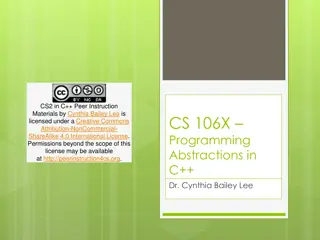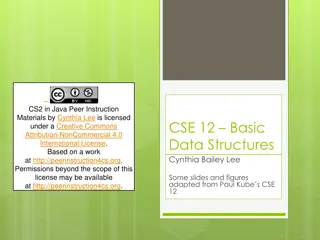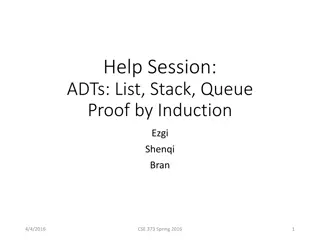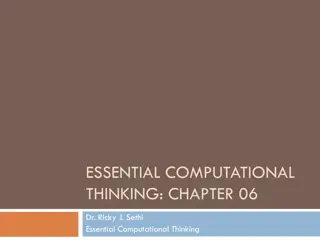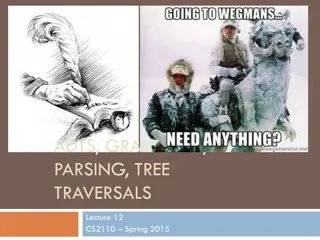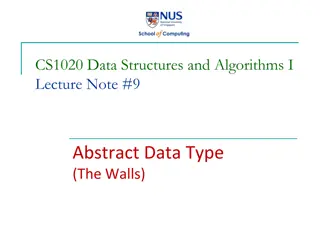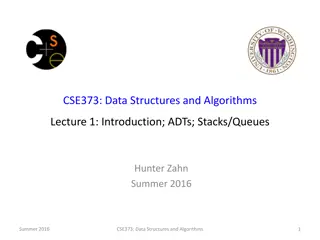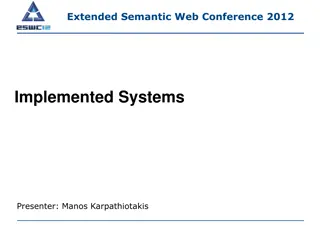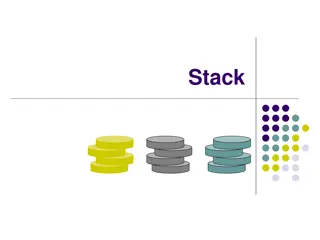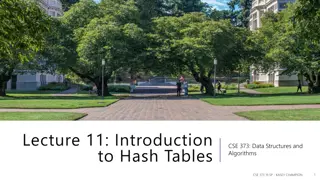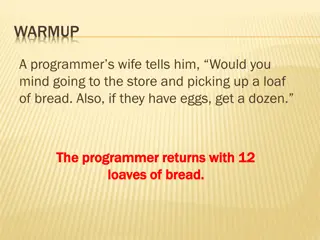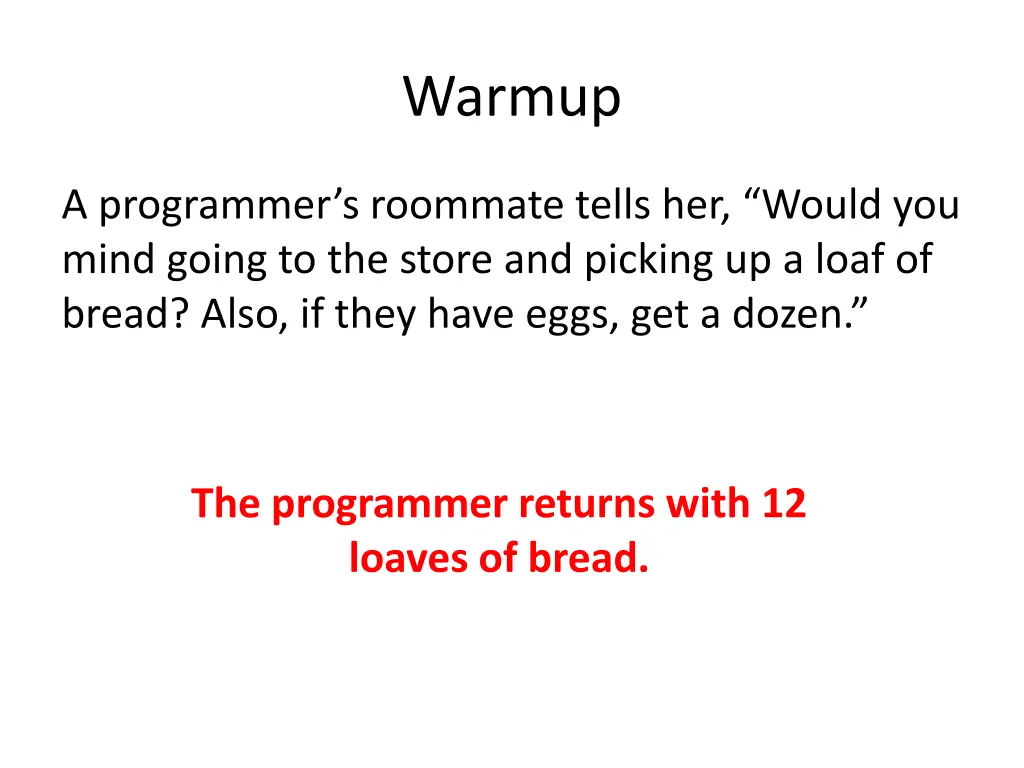
Polynomial Operations and ADTs
Explore polynomial operations and abstract data types (ADTs) in this comprehensive guide. Learn about RatNum, RatTerm, RatPoly, and RatPolyStack implementations. Dive into pseudocode algorithms, polynomial addition and subtraction, and more. Get ready to enhance your understanding of polynomial graphing calculators and rational numbers!
Download Presentation

Please find below an Image/Link to download the presentation.
The content on the website is provided AS IS for your information and personal use only. It may not be sold, licensed, or shared on other websites without obtaining consent from the author. If you encounter any issues during the download, it is possible that the publisher has removed the file from their server.
You are allowed to download the files provided on this website for personal or commercial use, subject to the condition that they are used lawfully. All files are the property of their respective owners.
The content on the website is provided AS IS for your information and personal use only. It may not be sold, licensed, or shared on other websites without obtaining consent from the author.
E N D
Presentation Transcript
Warmup A programmer s roommate tells her, Would you mind going to the store and picking up a loaf of bread? Also, if they have eggs, get a dozen. The programmer returns with 12 loaves of bread.
Section 3: HW4, ADTs, and more Justin Bare and Deric Pang with material from Vinod Rathnam, Alex Mariakakis,Krysta Yousoufian, Mike Ernst, Kellen Donohue
Agenda Announcements HW3: due tonight at 11pm HW4: due Thursday January 28 Polynomial arithmetic Abstract data types (ADT) Representation invariants (RI) Abstraction Functions Further information found in Calendar/info & docs/handouts link on website
HW4: Polynomial Graphing Calculator Problem 0: Write pseudocode algorithms for polynomial operations Problem 1: Answer questions about RatNum Problem 2: Implement RatTerm Problem 3: Implement RatPoly Problem 4: Implement RatPolyStack Problem 5: Try out the calculator
Rat Objects RatNum ADT for a Rational Number Has NaN RatTerm Single polynomial term Coefficient (RatNum) & degree RatPoly Sum of RatTerms RatPolyStack Ordered collection of RatPolys
Polynomial Addition (5x4 + 4x3 - x2 + 5) (3x5 - 2x3 + x 5) +
Polynomial Addition (5x4 + 4x3 - x2 + 5) (3x5 - 2x3 + x 5) + 5x4 + 4x3 - x2 0x + 5 3x5 0x4 - 2x3 0x2 + x 5 +
Polynomial Addition (5x4 + 4x3 - x2 + 5) (3x5 - 2x3 + x 5) + 5x4 + 4x3 - x2 0x + 5 3x5 0x4 - 2x3 0x2 + x 5 +
Polynomial Addition (5x4 + 4x3 - x2 + 5) (3x5 - 2x3 + x 5) + 5x4 + 4x3 - x2 0x + 5 3x5 0x4 - 2x3 0x2 + x 5 + 3x5 + 5x4 + 2x3 - x2 + x + 0
Polynomial Subtraction (5x4 + 4x3 - x2 + 5) (3x5 - 2x3 + x 5) - 5x4 + 4x3 - x2 0x + 5 3x5 0x4 - 2x3 0x2 + x 5 -
Polynomial Subtraction (5x4 + 4x3 - x2 + 5) (3x5 - 2x3 + x 5) - 5x4 + 4x3 - x2 0x + 5 3x5 0x4 - 2x3 0x2 + x 5 -
Polynomial Subtraction (5x4 + 4x3 - x2 + 5) (3x5 - 2x3 + x 5) - 5x4 + 4x3 - x2 0x + 5 3x5 0x4 - 2x3 0x2 + x 5 - -3x5 + 5x4 + 6x3 - x2 - x + 10
Polynomial Multiplication (4x3 - x2 + 5) (x 5) *
Polynomial Multiplication (4x3 - x2 + 5) (x 5) * 4x3 - x2 + 5 x 5 *
Polynomial Multiplication (4x3 - x2 + 5) (x 5) * 4x3 - x2 + 5 x 5 * -20x3 + 5x2 25
Polynomial Multiplication (4x3 - x2 + 5) (x 5) * 4x3 - x2 + 5 x 5 * -20x3 + 5x2 25 4x4 -x3 + 5x
Polynomial Multiplication (4x3 - x2 + 5) (x 5) * 4x3 - x2 + 5 x 5 * -20x3 + 5x2 25 4x4 -x3 + 5x + 4x4 -21x3 +5x2 + 5x - 25
Polynomial Division (5x6 + 4x4 x3 + 5) (x3 - 2x 5) /
Polynomial Division (5x6 + 4x4 x3 + 5) (x3 - 2x 5) / x3 - 2x 5 5x6 + 4x4 x3 + 5
Polynomial Division 1 0 -2 -5 5 0 4 -1 0 0 5
Polynomial Division 5 1 0 -2 -5 5 0 4 -1 0 0 5
Polynomial Division 5 1 0 -2 -5 5 0 4 -1 0 0 5 5 0-10 -25
Polynomial Division 5 1 0 -2 -5 5 0 4 -1 0 0 5 5 0-10 -25 0 0 14 24
Polynomial Division 5 1 0 -2 -5 5 0 4 -1 0 0 5 5 0-10 -25 0 0 14 24 14 24 0
Polynomial Division 5 0 1 0 -2 -5 5 0 4 -1 0 0 5 5 0-10 -25 0 0 14 24 14 24 0
Polynomial Division 5 0 1 0 -2 -5 5 0 4 -1 0 0 5 5 0-10 -25 0 0 14 24 14 24 0 14 24 0 0
Polynomial Division 5 0 14 1 0 -2 -5 5 0 4 -1 0 0 5 5 0-10 -25 0 0 14 24 14 24 0 14 24 0 0
Polynomial Division 5 0 14 1 0 -2 -5 5 0 4 -1 0 0 5 5 0-10 -25 0 0 14 24 14 24 0 14 24 0 0 14 0 -28 -70
Polynomial Division 5 0 14 1 0 -2 -5 5 0 4 -1 0 0 5 5 0-10 -25 0 0 14 24 14 24 0 14 24 0 0 14 0 -28 -70 0 24 28 70
Polynomial Division 5 0 14 1 0 -2 -5 5 0 4 -1 0 0 5 5 0-10 -25 0 0 14 24 14 24 0 14 24 0 0 14 0 -28 -70 0 24 28 70 24 28 70 5
Polynomial Division 5 0 14 24 1 0 -2 -5 5 0 4 -1 0 0 5 5 0-10 -25 0 0 14 24 14 24 0 14 24 0 0 14 0 -28 -70 0 24 28 70 24 28 70 5 24 0 -48 -120
Polynomial Division 5 0 14 24 1 0 -2 -5 5 0 4 -1 0 0 5 5 0-10 -25 0 0 14 24 14 24 0 14 24 0 0 14 0 -28 -70 0 24 28 70 24 28 70 5 24 0 -48 -120 0 28 118 125
Polynomial Division (5x6 + 4x4 x3 + 5) (x3 - 2x 5) / 5x3 + 14x + 24
Polynomial Division (5x6 + 4x4 x3 + 5) (x3 - 2x 5) / 28x2 + 118x + 125 x3 - 2x 5 5x3 + 14x + 24 +
ADT Example: Circle Suppose we want to make a Circle class that represents circles on the Cartesian plane y x
ADT Example: Circle /** * This class represents the mathematical concept of a circle. * */ public class Circle { // What goes here? }
Circle: Class Specification What represents the abstract state of a Circle? What are some properties of a circle we can determine? How can we implement this? What are some ways to break a circle?
Circle Implementation 1 public class Circle1 { private Point center; private double rad; } // Rep invariant: // // ...
Representation Invariants Constrains an object s internal state Maps concrete representation of object to a boolean If representation invariant is false/violated, the object is broken doesn t map to any abstract value
Circle Implementation 1 public class Circle1 { private Point center; private double rad; // Rep invariant: // center != null && rad > 0 // ... }
Circle Implementation 2 public class Circle2 { private Point center; private Point edge; } // Rep invariant: // // ...
Circle Implementation 2 public class Circle2 { private Point center; private Point edge; } // Rep invariant: // center != null && // edge != null && // !center.equals(edge) // ...
Circle Implementation 3 public class Circle3 { private Point corner1, corner2; // Rep invariant: // // ... }
Circle Implementation 3 public class Circle3 { private Point corner1, corner2; // Rep invariant: // corner1 != null && // corner2 != null && // !corner1.equals(corner2) // ... }
Checking Rep Invariants Representation invariant should hold before and after every public method Write and use checkRep() Call before and after public methods Make use of Java s assert syntax! OK that it adds extra code Asserts won t be included on release builds Important for finding bugs
checkRep() Example with Asserts public class Circle1 { private Point center; private double rad; private void checkRep() { assert center != null : This does not have a assert radius > 0 : This circle has a negative radius ; } center ; }
Using Asserts To enable asserts: Go to Run->Run Configurations ->Arguments tab-> input ea in VM arguments section Do this for every test file
Using Asserts Demo
Abstraction Function Abstraction function: a mapping from internal state to abstract value Abstract fields may not map directly to representation fields Circle has radius but not necessarily private int radius; Internal representation can be anything as long as it somehow encodes the abstract value Representation Invariant excludes values for which the abstraction function has no meaning
Circle Implementation 1 public class Circle1 { private Point center; private double rad; } // Abstraction function: // AF(this) = a circle c such that // c.center = // c.radius = // Rep invariant: // center != null && rad > 0 // ...




